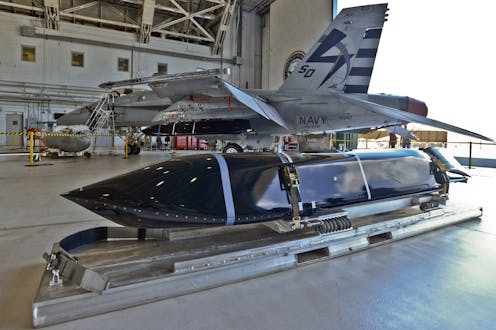Scott Morrison pivots Australian Defence Force to meet more threatening regional outlook
- Written by Michelle Grattan, Professorial Fellow, University of Canberra

Scott Morrison will deliver a stark warning that Australia faces an increasingly threatening regional outlook and announce a pivot in its defence posture, when he releases the government’s 2020 Defence Strategic Update on Wednesday.
The Prime Minister will declare: “Even as we stare down the COVID pandemic at home, we need to also prepare for a post COVID world that is poorer, more dangerous and more disorderly”.
He will say the Indo-Pacific is the “epicentre” of increasing strategic competition, highlight “fractious” United States-China relations, and point to rising regional tensions over territorial claims, notably in the South China Sea and on the India-China border.
Australia’s defence policy is being adjusted to concentrate on our immediate region, and to equip the Australian Defence Force (ADF) with greater capability for deterring threats, including by significant new investment in longer-range strike capabilities across air, sea and land.
Morrison will announce the government will buy the AGM-158C Long Range Anti-Ship Missile from the US Navy, costing about $800 million. This missile has a range of more than 370 kilometres and is a significant upgrade from the current Harpoon anti-ship missile.
The very blunt language and unvarnished tone of Morrison’s speech, released ahead of delivery, reflect the heightening regional uncertainty, as China’s power and assertiveness increase, and American policy is unpredictable.
The update comes as relations between Australia and China continue to deteriorate, with Australia pointing to cyber attacks from “a state-based” actor and China accusing Australia of spying on it.
In his speech Morrison says the 2016 Defence White Paper gave equal weighting across three areas: Australia and its northern approaches, Southeast Asia and the Pacific, and operations in support of the rules-based global order.
“In this update, the government has directed Defence to prioritise the ADF’s geographical focus on our immediate region – the area ranging from the north-east Indian Ocean, through maritime and mainland Southeast Asia to Papua New Guinea and the South West Pacific,” he says.
“With the Indo-Pacific experiencing fundamental shifts and increased threats, our commitment will deepen.
"Our defence forces will need to be prepared for any future, no matter how unlikely,” Morrison says.
“The government has set three new strategic objectives to guide all defence planning, including force structure, force generation, international engagement and operations,” he says. These are to
shape Australia’s strategic environment
deter actions against Australia’s interests
respond with credible military force, when required.
Morrison says maintaining a “largely defensive force” won’t be adequate to deter attacks against Australia or its interests in the challenging strategic environment the country faces.
The ADF’s deterrence capabilities must be strengthened.
It needs “capabilities that can hold potential adversaries’ forces and critical infrastructure at risk from a distance, thereby deterring an attack on Australia and helping to prevent war,” he says.
To meet the new circumstances, “Australia will invest in longer range strike weapons, cyber capabilities and area denial”.
“We will increase the Australian Defence Force’s ability to influence and deny operations directed against our interests — ones below the threshold of traditional armed conflict, in what experts call the ‘grey-zone’.
"This will involve boosting Defence’s special operations, intelligence and offensive cyber capabilities, as well as its presence operations, capacity-building efforts, and engagement activities.”
Outlining the worsening risks, Morrison says: “We have moved into a new and less benign strategic era – one in which the institutions and patterns of cooperation that have benefited our prosperity and security for decades are under increasing strain.
"The Indo-Pacific is the epicentre of rising strategic competition.
"Our region will not only shape our future - increasingly it is the focus of the dominant global contest of our age.
"Tensions over territorial claims are rising across the Indo-Pacific region - as we have seen recently on the disputed border between India and China, in the South China Sea, and in the East China Sea.
"The risk of miscalculation - and even conflict - is heightening.
"Regional military modernisation is occurring at an unprecedented rate.
"Capabilities and reach are expanding.
"Previous assumptions of enduring advantage and technological edge are no longer constants.
"Coercive activities are rife.
"Disinformation and foreign interference have been enabled by new and emerging technologies.
"Terrorism and the evil ideologies that underpin it remain a tenacious threat.
"And state sovereignty is under pressure — as are rules and norms, and the stability these help provide.
"Relations between China and the United States are fractious as they compete for political, economic and technological supremacy,” Morrison says.
He says “the largely benign security environment Australia has enjoyed - roughly from the fall of the Berlin Wall to the Global Financial Crisis - is gone.”
The government’s updated defence funding will see investment in capability grow to $270 billion over the next decade. This compares with the $195 billion decade-long commitment in the 2016 White Paper.
Australia’s sharpened regional focus would have the ADF forming even deeper links with regional armed forces.
“Our new strategic settings will also make us a better, more effective ally.”
However, in a message that Australia no longer is as keen to be drawn into situations further afield, Morrison says, “We remain prepared to make military contributions outside of our immediate region where it is in our national interest to do so, including in support of US-led coalitions.
"But we cannot allow consideration of such contingencies to drive our force structure to the detriment of ensuring we have credible capability to respond to any challenge in our immediate region.
"It is in our region that we must be most capable in the military contributions we make to partnerships, and to our ever-closer alliance with the United States.”

